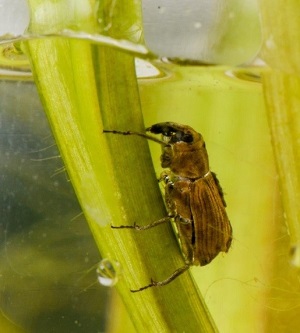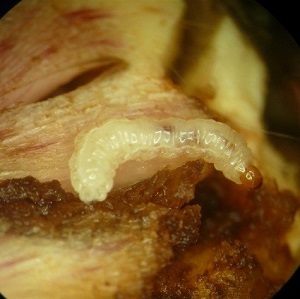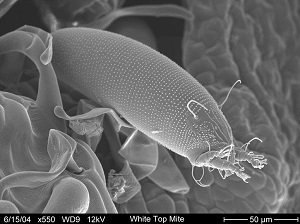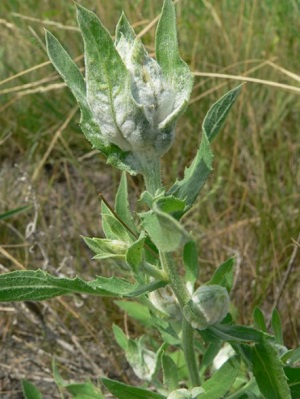Biological Weed Control Research Update- December 2014
Download this weed post on biocontrol research as a PDF
Biological weed control research is a long process. Typically, agents are studied for 5-10 years before the researchers submit a petition to APHIS’s Technical Advisory Group on the Biological Control of Weeds (TAG). The mission of TAG is to facilitate biological control of weeds in North America by providing guidance to researchers and recommendations to regulating agencies for or against the release of biocontrol agents. The advisory group is primarily comprised of representatives from federal agencies. The TAG review takes approximate one year. TAG has the ability to ask for additional research to be conducted, to recommend the agents for field release, or to deny the release. If additional research is requested, it will be completed and then the project will be resubmitted to TAG. After a favorable TAG review, APHIS drafts an environmental assessment (EA) for the release of the biocontrol agent. The EA is reviewed by APHIS, U.S. Fish & Wildlife Service (for concerns about Threated & Endangered species), Native American Tribes and comments from the general public. The EA process adds another 1-2 years to the review. Because of the length and complexity of this research/review process, it is helpful to have regular updates from researchers concerning the status of the projects they are working on. Below are two such updates that were presented at the Biological Weed Control Working Group fall meeting.
If you are interested in more information on these projects or other biological control projects in Montana, contact Melissa Maggio-Kassner at [email protected] for further information.
Flowering rush
Peter Rice, a Research Ecologist at the University of Montana, is heading the effort to develop a biological control system for flowering rush. This project appears to be moving along much more rapidly than some, likely because flowering rush is the only plant in its family in North America. This means flowering rush does not have close relatives here that specialist insects may cross over to and damage.
Currently, there are four potential agents that are being researched in Europe. One of the four, Bagous nodulosus, is a weevil. Adult weevils have been collected from the leaves above and below the water surface. The larvae feed on the leaf bases and rhizomes of flowering rush. Initial host specificity tests on ten different species indicated that the weevil will not lay eggs on any other species than flowering rush. In 2015, additional tests will be conducted on this agent to further evaluate it for host specificity and impact on flowering rush. The European scientists that are conducting the research are also hoping to improve rearing methods for Bagous nodulosus and to collect and begin detailed investigations for the three other potential agents.
Whitetop and Russian knapweed
Jeff Littlefield (Montana State University) along with European and U.S. cooperators are working on a number of biological weed control research projects including whitetop and Russian knapweed.
A number of insects have been researched for whitetop control by European scientists, MSU and the USDA-Agricultural Research Service. The stem and flower mite Aceria drabae, has been recommended by TAG and an EA has been drafted, which is currently being reviewed for final approval. This mite reduces seed production and may stunt the plant. Since whitetop has an extensive root system, this agent is not likely to be a plant killer but a plant stressor that will limit the plant’s distribution by reducing seed production. If all goes well it is possible that it will be approved for field release in 2015. Four other insects are still in the research phase overseas.
Two insects that target Russian knapweed have recently been added to the list of approved agents for field release. Jaapiella ivannikovi, a tip gall midge, appears to have an impact on the weed especially where the agent is combined with properly-timed mowing, herbicide use, or grazing. Aulacidea acroptilonica is a stem galling wasp that stunts plant growth. However, these wasps are fed upon by native parasitoids, grazing livestock and rodents which can hinder population growth. Both the wasp and midge are well established in Montana and may build-up high populations. Studies have been initiated to determine the effect of these agents on the clonal nature of the plant. In addition to these newly approved agents, there are two additional agents, a flower mite and a defoliating leaf beetle that are still being researched by European collaborators.
As mentioned previously, this just highlights a few of the many biocontrol projects that are currently being researched. If you have questions about these projects or the status of biocontrol for other noxious weeds not featured, contact Melissa Maggio-Kassner at [email protected].
Bagous nodulosus weevil feeding underwater on flowering rush stem

Bagous nodulosus larva damage at leaf base of flowering rush
Bagous nodulosus larva damage at leaf base of flowering rush

Aceria drabae mite
Aceria drabae mite

Galls formed by Jaapiella tip gall midge
Galls formed by Jaapiella tip gall midge

